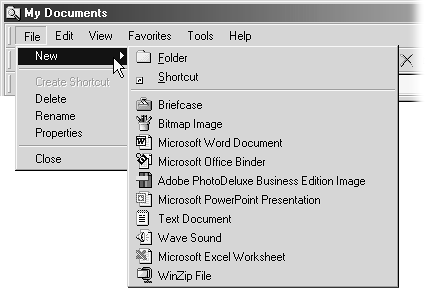Every window in Windows, and every window in software written to run in Windows, has a menu bar. Menu bars usually have a menu named File at the left end, and Help at the far right. What comes between depends on the type of software and its functions.
This appendix covers the commands in the Windows 2000 Professional desktop windows.
Tip
Frequently, you'll find that some menu commands are grayed out, meaning that they're not available for use. You can usually figure out why. For example, the Copy command is grayed out unless you've highlighted something to copy. Other reasons for inaccessible commands can be a little more difficult to parse; this appendix also addresses what to do to make grayed out commands available.
Along with the Help menu, the File menu is the most universal one in Windows and Windows applications. Its commands may vary depending on whether or not you've highlighted an icon in the window.
Opens the selected icon:
If the icon is a drive or a folder, this command opens a window that displays the drive/folder's contents.
If the icon is a program file, the program opens.
If the icon is a data file, it opens in the program that created it.
If grayed out: Select an icon.
Opens a submenu of choices for new icons you can create in the window (see Figure B-1).
Creates a shortcut to the selected icon (see page 101). For folders and files, the shortcut is placed in the current window, right next to the original icon, where the shortcut isn't especially useful. Drag the shortcut to the desktop or the Quick Launch toolbar. If the selected icon is a drive, Windows 2000 displays a message telling you that you can't create a shortcut to a drive on the drive, and asks if you want to put the shortcut on the desktop.
If grayed out: Select an icon.
Deletes the selected folder or file. (The command is not available if the selected icon is a drive). Windows 2000 asks you to confirm the fact that you are deleting the icon.
If grayed out: Highlight the file or folder you want to delete.
Lets you change the name of the selected icon (see Section 5.2.1).
If grayed out: Select the file or folder you want to rename.
Opens Windows Explorer (Section 5.1.1) to display the contents of the selected folder or disk. (If you select a file instead of a drive or folder, this command doesn't appear on the menu at all.)
Opens a Search window that's configured to look in the selected drive or folder (Section 3.6). (Again, this command doesn't appear on the menu at all unless you've highlighted a drive or folder.)
Opens the Sharing tab for a selected drive, folder, or printer where you can enable or disable sharing (page Section 13.3.2). This command appears only when a folder, drive, or printer icon is highlighted.
Selecting this command (which is available only for files and folders, not drives) displays a submenu that lists the choices on your system for Send To. See page 97 for details on using this command.
Opens the Properties dialog box for the selected icon. See Section 5.2.2 for details on the resulting dialog box.

